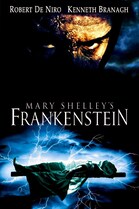|
Mary Shelley’s Frankenstein (1994) is an R-rated horror movie that runs two hours. It was directed by Kenneth Branagh and the screenplay, which is based on Mary Shelley’s novel, was written by Steph Lady and Frank Darabont. A few days ago it was Mary Shelley’s birthday. Shelley, née Mary Wollstonecraft Godwin and daughter of the English author Mary Wollstonecraft, was born in London on August 30, 1797. Her novel, Frankenstein; or, The Modern Prometheus, which she began in the summer of 1816, has inspired numerous film adaptations and related movies, including Frankenstein (1931), starring Boris Karloff as the Creature. In Mary Shelley’s Frankenstein Robert De Niro plays the Creature, Victor Frankenstein is played by Kenneth Branagh and Helena Bonham Carter plays Elizabeth, Victor’s adoptive sister and love interest. The story, set in Switzerland in the late 18th century, is about a scientist whose life is destroyed by his creation. This film made over US$112 million at worldwide box office. It has things to offer female viewers, but there are drawbacks. My film commentaries aren’t full movie reviews, and the aspect of this film that I want to shine a spotlight on today is violence against women. Mary Shelley’s Frankenstein includes violence against women throughout, some of it quite graphic. The female characters do not fare well and this merits discussion. For starters it includes four deaths of women. Over and above these deaths, two of which are gynocides, women are victims of break and enter, assault and manhandling, all committed by males. The lead female (Helena Bonham Carter) suffers violence in several scenes. She dies a horrible death twice. Kenneth Branagh and Robert De Niro grab her in various scenes. De Niro breaks into her room, climbs on top of her in bed, clamps a hand over her mouth and rips out her heart. Branagh decapitates her with a meat cleaver. She also sets herself on fire with an oil lamp and runs down a hall, engulfed in flames, before falling from three stories to her death. She is not the only female character to fare badly. Trevyn McDowell, a secondary character, is dragged away by two men, then one puts a noose around her neck, men push her off a rooftop and she falls several stories to her death (in front of her mother). Also, Cherie Lunghi, another secondary character, dies in childbirth. In my upcoming film guide for women, which contains 500 feature film reviews, I discuss all kinds of things about Mary Shelley’s Frankenstein. I look forward to sharing my findings about mainstream movies of the 20th and 21st centuries and what they have to offer female viewers. Copyright © 2020 Alline Cormier
0 Comments
Leave a Reply. |
Categories |


 RSS Feed
RSS Feed